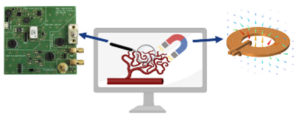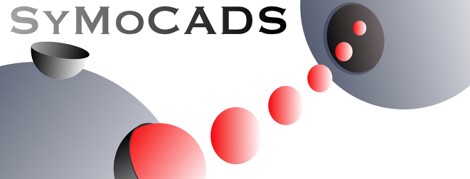Project P5
P5: Lumped-Parameter Models for and Optimization of SPION Steering in Highly Branched Vascular and Tissue Structures

Motivation and state of the art:
Drug-loaded magnetic nanoparticles are used for the therapy of arteriosclerosis1,2 and cancer3,4. For both application scenarios, Christoph Alexiou’s research group has demonstrated the efficiency of SPION steering for magnetic drug targeting in preclinical studies5,6. In addition to these in vivo studies, for simple and idealized setups, magnetic particle steering has been investigated experimentally in lab settings and via simulations. For example, the targeting of brain tumors was considered in 7,8, where the tissue was assumed homogenous. The majority of existing works investigate particle steering at T-, Y- or half-Y-shaped channel branches, as a simplified model of particle propagation in blood vessels, and experimental9-11 and simulation-based11-13 results have been reported. However, a comprehensive numerical model that captures the full complexity of the MC channel formed by vascular and tissue structures, including highly branched sections, particle transport across vessel walls, and the impact of forces beyond those created by fluid flow and the steering magnetic field (see also P4), is not available, but is needed for accurate simulation-based performance evaluation of magnetic particle steering systems. Furthermore, the impact of specific parameters of particle steering systems, e.g., the position of the magnet10-11 or an alternating coil current9,10,12 on steering efficiency has been investigated. However, a systematic approach for optimization of all parameters of the steering and injection systems (e.g., the number, positions, orientations, and field strengths of the coils of the steering electromagnet; the location, volume, duration, and particle concentration of the injection) in order to maximize the number of SPIONs in a target region (i.e., the tumor tissue) has not been reported, yet. One obstacle in this regard is that a suitable approximate MC channel model amenable for steering algorithm development is not available. Such a model has to capture the impact of all parameters of the actual MC channel relevant for particle steering but also has to be simple enough to enable efficient steering algorithm design. Alternative approaches in the literature consider steering by hand, where a human operator guides the particles in real-time based on imaging data, either in homogeneous tissue8,14,15 or fluidic channels16,17, which however is expensive and requires significant training.
Objectives:
The goal of this project is to establish MC-based models and algorithms for optimization of SPION steering systems in highly branched vascular and tissue structures. To this end, a comprehensive numerical model for the MC channel relevant for SPION steering will be derived. Furthermore, in order to enable efficient optimization of the SPION steering system at affordable computational cost, a lumped-parameter approach will be used to develop approximate models. Based on these approximate models, given a certain vessel topology and tissue structure, algorithms for maximization of the number of particles delivered to a target area (representing the MC receiver) will be investigated, where both static and dynamic (time-varying) steering systems will be considered. The findings of P4 regarding the forces relevant for SPION steering will be integrated for development of the proposed comprehensive and approximate MC channel models as they become available. Furthermore, besides conventional electromagnets, the linear array structures investigated in P4 will be considered for steering algorithm design. Moreover, the developed MC channel models and steering algorithms will be experimentally validated and refined exploiting the physical tumor models provided by P6.
References
1.Manshadi et al., ”Delivery of Magnetic Micro/nanoparticles and Magnetic-based Drug/Cargo Into Arterial Flow for Targeted Therapy,“ Drug Deliv., vol. 25, pp. 1963-1973, 2018.
2.Matuszak, B. Lutz, A. Sekita, J. Zaloga, C. Alexiou, S. Lyer, and I. Cicha. ”Drug Delivery to Atherosclerotic Plaques Using Superparamagnetic Iron Oxide Nanoparticles,“ Int. J. Nanomed., vol. 13, pp. 8443-8460, 2018.
3.Bejarano et al., ”Nanoparticles for Diagnosis and Therapy of Atherosclerosis and Myocardial Infarction: Evolution Toward Prospective Theranostic Approaches,“ Theranostics, vol. 8, pp. 4710-4732, 2018.
4.Yigit, A. Moore, and Z. Medarova. ”Magnetic Nanoparticles for Cancer Diagnosis and Therapy,“ Pharm. Res., vol. 29, pp. 1180-1188, 2012.
5.Alexiou, W. Arnold, R. Klein, F. Parak, P. Hulin, C. Bergemann, W. Erhardt, S. Wagenpfeil, and A. Lübbe, ”Locoregional Cancer Treatment with Magnetic Drug Targeting,“ Cancer Res., vol. 23, pp. 6641-6648, 2000.
6.Cicha, S. Lyer, C. Janko, R. Friedrich, M. Pöttler, and C. Alexiou, ”Magnetic Nanoparticles for Medical Applications,“ Nanomed., vol. 12, no. 8, pp. 825-829, 2017.
7.Le, M. Bui, and J. Yoon, „An Optimal Design of an Electromagnetic Actuator for Targeting Magnetic Micro-/Nano-Carriers in a Desired Region,“ IEEE Trans. Magn., vol. 54, pp. 1-5, Nov. 2018.
8.Weinberg et al., ”Platform for Image-Guided Noninvasive Brain Delivery of Magnetic Particles: Concept and Technical Progress,“ IEEE Magn. Lett., vol. 9, pp. 1-5, 2018.
9.Do et al., ”An Electromagnetic Steering System for Magnetic Nanoparticle Drug Delivery,“ in Proc. 12th Int. Conf. Ubiquitous Robots Ambient. Intell., pp. 528-531, 2015.
10.Gitter and S. Odenbach, „Experimental Investigations on a Branched Tube Model in Magnetic Drug Targeting,“ J. Magn. Magn. Mater., vol. 323, pp. 1413-1416, May 2011.
11.Hoshiar, T. Le, F. Amin, M. Kim, and J. Yoon, „Functionalized Electromagnetic Actuation Method for Aggregated Nanoparticles Steering,“ in Proc. 39th Annual Int. Conf. IEEE Eng. Med. Biol. Soc. (EMBC), pp. 885-888, 2017.
12.Tehrani, J. Yoon, M. Kim, and J. Yoon, „A Novel Scheme for Nanoparticle Steering in Blood Vessels Using a Functionalized Magnetic Field,“ IEEE Trans. Biomed. Eng., vol. 62, pp. 303-313, Jan. 2015.
13.K. Gitter and S. Odenbach, „Investigations on a Branched Tube Model in Magnetic Drug Targeting-Systematic Measurements and Simulation,“ IEEE Trans. Magn., vol. 49, pp. 343-348, Jan. 2013.
14.Bui, T.-A. Le, and J. Yoon, ”A Magnetic Particle Imaging-Based Navigation Platform for Magnetic Nanoparticles Using Interactive Manipulation of a Virtual Field Free Point to Ensure Targeted Drug Delivery,“ IEEE Trans. Ind. Electron., vol. 68, pp. 12493-12503, 2021.
15.Mahmood et al., ”A Novel Design of an MPI-Based Guidance System for Simultaneous Actuation and Monitoring of Magnetic Nanoparticles,“ IEEE Trans. Magn., vol. 51, pp. 1-5, 2015.
16.Park et al., ”A Novel Shared Guidance Scheme for Intelligent Haptic Interaction Based Swarm Control of Magnetic Nanoparticles in Blood Vessels,“ IEEE Access, vol. 8, pp. 106714-106725, 2020.
17.Park and J. Yoon. ”User-Interfaced Guidance Scheme for Steering Swarm of magnetic nanoparticles,“ in Proc. 21st Int. Conf. Control Autom. Syst. (ICCAS), pp. 1716-1719, 2021.
